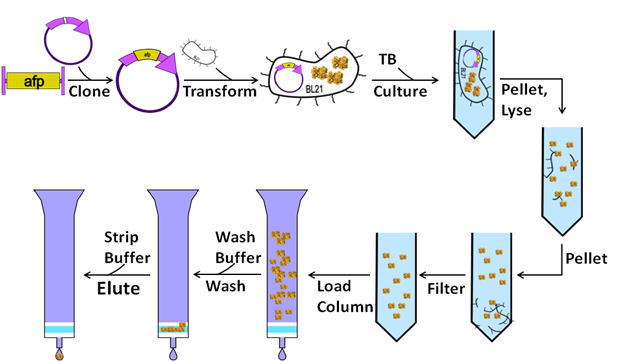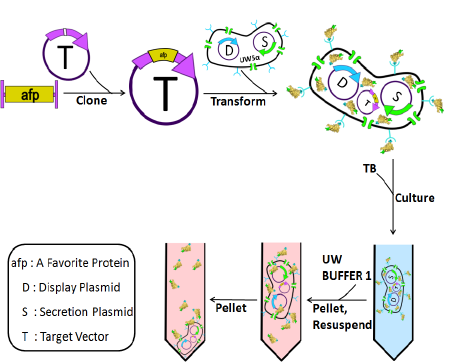Team:Washington/Project
From 2009.igem.org
(→) |
(→Idealized Protein Production and Purification) |
||
| (58 intermediate revisions not shown) | |||
| Line 2: | Line 2: | ||
{{Template:Team:Washington/Templates/Header}} | {{Template:Team:Washington/Templates/Header}} | ||
| - | = | + | == Traditional Protein Purification vs Our System: Ideal Protein Purification == |
| - | + | ||
| - | + | The ability to quickly and cheaply generate purified proteins is a useful skill for aspiring synthetic biologists and iGEM participants alike, since purified proteins are used in many key laboratory processes. Although some commonly used proteins (like the restriction enzymes EcoRI, XbaI, SpeI, and PstI) can be bought, many applications require synthetic biologists to purify their own proteins, either to study or for use in atypical biological processes. Many members of our team have personal experience purifying proteins and have found it to be a slow and tedious process. For these reasons, the UW 2009 iGEM team has designed an Idealized Protein Purification (IPP) scheme designed to speed up protein purification, in the hopes of making protein purification facile and accessible for synthetic biologists, as well as potentially making previously difficult-to-purify proteins easier to generate. | |
| - | = | + | ==Traditional Protein Production and Purification== |
| - | + | ||
| - | [[Image:OldPurificationGraphic.png]] | + | [[Image:OldPurificationGraphic.png|500px|center]] |
| - | + | Recombinant protein purification<sup>1</sup> is a method whose basic steps have not changed significantly in over two decades - thus we believe this process is due for an overhaul. Traditional protein purification steps require expensive and specialized equipment (such as an ultracentrifuge and columns that bind His tags) that may not be accessible to the average synthetic biologist. Traditional protein production and purification typically consists of the following three protein production steps and six purification steps: | |
| - | # | + | |
| - | # Transform this plasmid into an expression strain of bacteria | + | *TRADITIONAL PROTEIN PRODUCTION<sup>1</sup> |
| - | # Culture cells and induce protein expression allowing cells to grow to high density | + | # Clone in a favorite protein (referenced here as afp) into an expression plasmid designed to generate lots of protein fused with a His tag. |
| - | + | # Transform this plasmid into an expression strain of bacteria specialized in protein production. | |
| - | # | + | # Culture cells and induce protein expression, allowing cells to grow to high density. |
| - | # | + | *TRADITIONAL PROTEIN PURIFICATION<sup>1</sup> |
| - | # Filter the supernatant to remove any lingering debris before being added to an affinity column. This | + | # Pellet cells, re-suspend in a lysis buffer and incubate to ensure full cell lysis, releasing proteins trapped within the cell into the media. |
| - | # Run the filtered | + | # Subject cell debris to a long, high-speed spin in an ultra-centrifuge to remove remaining insoluble matter (membrane, insoluble proteins, etc) and leave soluble proteins in the supernatant. |
| + | # Filter the supernatant to remove any lingering debris before being added to an affinity column. This ensures that the columns do not get clogged. | ||
| + | # Run the filtered supernatant over an affinity column several times to ensure thorough binding of His-tagged Afp to affinity column. | ||
# Flow wash buffer over column to eliminate proteins that non-specifically bind to the column. | # Flow wash buffer over column to eliminate proteins that non-specifically bind to the column. | ||
| - | # Collect | + | # Collect Afp by running an elution buffer over the column to release Afp. |
| + | |||
| - | Though not necessarily hard, | + | Though not necessarily hard, the traditional purification process is tedious and time consuming, taking us about three and a half hours to complete on purification day. With this in mind, we created an idealized protein purification scheme that is easier, cheaper and faster than the traditional method. |
| - | = | + | ==Idealized Protein Production and Purification== |
| - | + | ||
| - | [[Image:NewPurificationGraphic.png]] | + | [[Image:NewPurificationGraphic.png|500px|center]] |
| - | To avoid all the | + | To avoid all the laborious purification steps present in traditional protein purification we designed a system (Ideal Protein Purification) in which the cell, not the researcher, performs the purification steps to make recombinant protein product. Ideal Protein Purification reduces purification to two easy steps (cloning remains the same): |
| - | # Clone afp into | + | *IDEALIZED PROTEIN PRODUCTION (IPP) |
| - | # Transform the target vector with the | + | # Clone afp into the IPP "target vector". This creates a fusion protein in which a "display tag" <sup>2</sup> (called the Nano-Tag) is fused to the to the N-terminus of Afp, and a "secretion tag" to the C-terminus. |
| - | # Grow up cells and induce the expression of afp, just as in the | + | # Transform the target vector with the afp insert into cells already containing two additional plasmids. The first is a "Secretion plasmid", which contains all the parts of a type 1 secretion system from ''Erwinia chrysanthemi'' <sup>3</sup> that specifically recognizes proteins that harbor the secretion tag and exports them outside of the cell. The second is a "Display plasmid" which expresses a protein that is directed to the cell surface <sup>4</sup> and can bind to the "display tag", and then subsequently release the display tag when a specific small molecule is introduced to the system<sup>2</sup>. |
| - | # Spin down the cells | + | # Grow up cells in our specialized cell line that contains both Secretion and Display plasmids and induce the expression of afp, just as in the traditional protein purification method. As the protein is produced, it gets secreted to the media via the secretion system, and then binds to the outside of the cells via the display system. Now your protein of interest is non-covalently attached to the outside of the cell. |
| - | + | *IDEALIZED PROTEIN PURIFICATION | |
| - | # Collect | + | # Spin down the cells and re-suspend in an elution buffer containing a small molecule which disrupts the interaction between the display tag and the protein it was binding to on the surface of the cells. This causes Afp to be released from the surface of the cell. |
| + | # Collect Afp by pelleting the cells again and keeping the supernatant, which contains your purified protein. | ||
| - | This process should take about 10 minutes, quick enough to do between classes! In addition to saving time, our idealized protein purification method has other potential advantages over older methods. By keeping the cells intact, contaminants are not released into the media, which should result in purer protein product. A host of proteins toxic to E. coli could | + | This process should take about 10 minutes, quick enough to do between classes! In addition to saving time, our idealized protein purification method has other potential advantages over older methods. By keeping the cells intact, contaminants are not released into the media, which should result in purer protein product. A host of proteins normally toxic to ''E. coli'' in the traditional protein purification system could be grown in the Ideal Protein Purification system since they would be secreted outside of the cell before reaching high intra-cellular concentrations. Alternately, some proteins cannot properly fold in ''E. coli'', but by secreting these proteins into the appropriate media, they might fold correctly. Finally, there are some environmental applications, such as detoxification, where it is desirable to have a bacterium capable of secreting protein into the environment, which our system could be easily modified to do. |
| + | <div style="text-align:right">'''Continue to [https://2009.igem.org/Team:Washington/Project/Target Target >]'''</div> | ||
| + | ---- | ||
| + | ====Citations==== | ||
| + | #Protein production and purification, Structural Genomics Consortium et.al. Nature Methods Vol.5 NO.2, February 2008 | ||
| + | #TAG: Lamla and Erdmann. [http://www.ncbi.nlm.nih.gov/pubmed/14680960 The Nano-tag, a streptavidin-binding peptide for the purification and detection of recombinant proteins.] | ||
| + | #Palacios et al. [http://www.ncbi.nlm.nih.gov/pubmed/11157948 Subset of Hybrid Eukaryotic Proteins Is Exported by the Type I Secretion System of Erwinia chrysanthemi, Secretion of GFP in E. Coli] | ||
| + | #Cell Surface Streptavidin, P. Tsai. IET Synth. Biol., Vol. 1, No. 1–2, 2007 | ||
{{Template:Team:Washington/Templates/Footer}} | {{Template:Team:Washington/Templates/Footer}} | ||
Latest revision as of 20:58, 20 October 2009
Traditional Protein Purification vs Our System: Ideal Protein Purification
The ability to quickly and cheaply generate purified proteins is a useful skill for aspiring synthetic biologists and iGEM participants alike, since purified proteins are used in many key laboratory processes. Although some commonly used proteins (like the restriction enzymes EcoRI, XbaI, SpeI, and PstI) can be bought, many applications require synthetic biologists to purify their own proteins, either to study or for use in atypical biological processes. Many members of our team have personal experience purifying proteins and have found it to be a slow and tedious process. For these reasons, the UW 2009 iGEM team has designed an Idealized Protein Purification (IPP) scheme designed to speed up protein purification, in the hopes of making protein purification facile and accessible for synthetic biologists, as well as potentially making previously difficult-to-purify proteins easier to generate.
Traditional Protein Production and Purification
Recombinant protein purification1 is a method whose basic steps have not changed significantly in over two decades - thus we believe this process is due for an overhaul. Traditional protein purification steps require expensive and specialized equipment (such as an ultracentrifuge and columns that bind His tags) that may not be accessible to the average synthetic biologist. Traditional protein production and purification typically consists of the following three protein production steps and six purification steps:
- TRADITIONAL PROTEIN PRODUCTION1
- Clone in a favorite protein (referenced here as afp) into an expression plasmid designed to generate lots of protein fused with a His tag.
- Transform this plasmid into an expression strain of bacteria specialized in protein production.
- Culture cells and induce protein expression, allowing cells to grow to high density.
- TRADITIONAL PROTEIN PURIFICATION1
- Pellet cells, re-suspend in a lysis buffer and incubate to ensure full cell lysis, releasing proteins trapped within the cell into the media.
- Subject cell debris to a long, high-speed spin in an ultra-centrifuge to remove remaining insoluble matter (membrane, insoluble proteins, etc) and leave soluble proteins in the supernatant.
- Filter the supernatant to remove any lingering debris before being added to an affinity column. This ensures that the columns do not get clogged.
- Run the filtered supernatant over an affinity column several times to ensure thorough binding of His-tagged Afp to affinity column.
- Flow wash buffer over column to eliminate proteins that non-specifically bind to the column.
- Collect Afp by running an elution buffer over the column to release Afp.
Though not necessarily hard, the traditional purification process is tedious and time consuming, taking us about three and a half hours to complete on purification day. With this in mind, we created an idealized protein purification scheme that is easier, cheaper and faster than the traditional method.
Idealized Protein Production and Purification
To avoid all the laborious purification steps present in traditional protein purification we designed a system (Ideal Protein Purification) in which the cell, not the researcher, performs the purification steps to make recombinant protein product. Ideal Protein Purification reduces purification to two easy steps (cloning remains the same):
- IDEALIZED PROTEIN PRODUCTION (IPP)
- Clone afp into the IPP "target vector". This creates a fusion protein in which a "display tag" 2 (called the Nano-Tag) is fused to the to the N-terminus of Afp, and a "secretion tag" to the C-terminus.
- Transform the target vector with the afp insert into cells already containing two additional plasmids. The first is a "Secretion plasmid", which contains all the parts of a type 1 secretion system from Erwinia chrysanthemi 3 that specifically recognizes proteins that harbor the secretion tag and exports them outside of the cell. The second is a "Display plasmid" which expresses a protein that is directed to the cell surface 4 and can bind to the "display tag", and then subsequently release the display tag when a specific small molecule is introduced to the system2.
- Grow up cells in our specialized cell line that contains both Secretion and Display plasmids and induce the expression of afp, just as in the traditional protein purification method. As the protein is produced, it gets secreted to the media via the secretion system, and then binds to the outside of the cells via the display system. Now your protein of interest is non-covalently attached to the outside of the cell.
- IDEALIZED PROTEIN PURIFICATION
- Spin down the cells and re-suspend in an elution buffer containing a small molecule which disrupts the interaction between the display tag and the protein it was binding to on the surface of the cells. This causes Afp to be released from the surface of the cell.
- Collect Afp by pelleting the cells again and keeping the supernatant, which contains your purified protein.
This process should take about 10 minutes, quick enough to do between classes! In addition to saving time, our idealized protein purification method has other potential advantages over older methods. By keeping the cells intact, contaminants are not released into the media, which should result in purer protein product. A host of proteins normally toxic to E. coli in the traditional protein purification system could be grown in the Ideal Protein Purification system since they would be secreted outside of the cell before reaching high intra-cellular concentrations. Alternately, some proteins cannot properly fold in E. coli, but by secreting these proteins into the appropriate media, they might fold correctly. Finally, there are some environmental applications, such as detoxification, where it is desirable to have a bacterium capable of secreting protein into the environment, which our system could be easily modified to do.
Citations
- Protein production and purification, Structural Genomics Consortium et.al. Nature Methods Vol.5 NO.2, February 2008
- TAG: Lamla and Erdmann. The Nano-tag, a streptavidin-binding peptide for the purification and detection of recombinant proteins.
- Palacios et al. Subset of Hybrid Eukaryotic Proteins Is Exported by the Type I Secretion System of Erwinia chrysanthemi, Secretion of GFP in E. Coli
- Cell Surface Streptavidin, P. Tsai. IET Synth. Biol., Vol. 1, No. 1–2, 2007
 "
"



